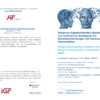Description
P 1175 – Safeguarding welding conditions and technical design of welded joints in martensitic stainless steels
The aim of the project is to develop the weldability of constructions made of presshardened 1.4034. Within the framework of the welding investigation, the focus is on optimising the parameters with regard to crack resistance, the application to contour welds, and the improvement of the strength and toughness of the joint. Therefor sheet metal of martensitic chromium steel was joined with established and modern materials in the ssimilar and dissimilar joints. Joining was carried out in all joint types. The loadbearing capacity is tested under quasi-static and impact loads. The focus is on testing contour-welded seams. The understanding of the relationship between joint characteristics and loading direction is to be improved. An analysis is to provide information on the mechanics of failure. Fatigue tests are carried out on butt and lap joints with a given variation of welding parameters. From this, cyclic strength data will be derived for optimum parameters. The investigation is extended to the fatigue strength of the reference material in dissimilar butt and lap joints. The results serve as a basis for the design of welded joints with ultra-high strength steels. Process diagrams for manufacturing and specifications for the design of processes and tools are derived.
The characteristic values for load-bearing capacity and fatigue strength result in material-specific guide values for the calculation of welded joints. Processes and construction are incorporated into the design and manufacture of a test component. In this way, the validity of the determined data is checked. The main field of application is sheet metal working. Target applications are primarily in vehicle construction for road and rail. In the area of profile machining, the solution approaches can be applied in lifting conveyors, ship decks and aircraft parts. The results of the process development will find their way into the design of a battery casing with an integrated, exchangeable crash frame for applications in electrically powered vehicles.
Published in:
2021
Authors:
Prof. Dr. rer. nat. R. Poprawe, Prof. Dr.-Ing. T. Melz, Prof. Dr.-Ing. G. Meschut




